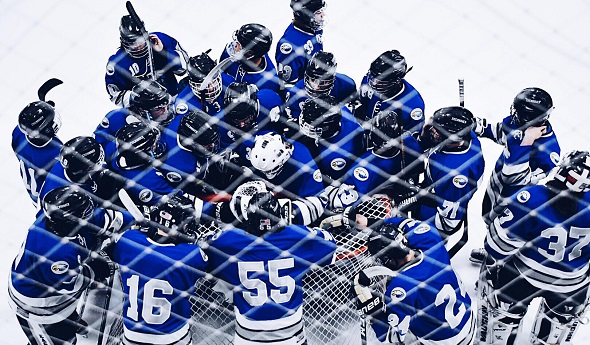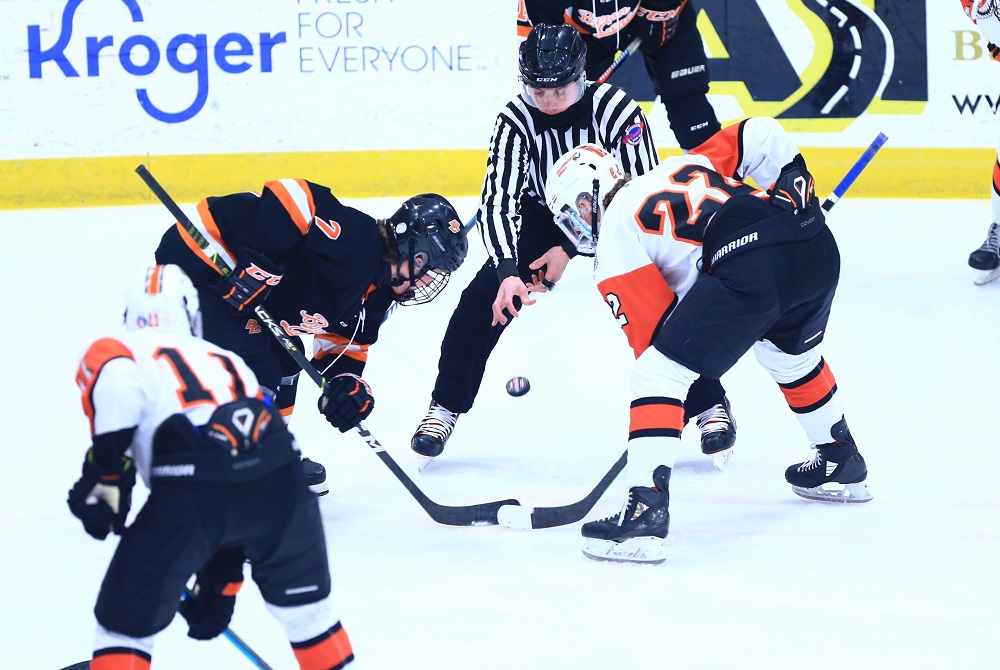
Numbers Add Up Nicely for Eisenhower
By
Tom Markowski
Special for Second Half
February 15, 2018
SHELBY TOWNSHIP – The game within the game continues to play out in boys ice hockey as coaches and communities strive to maintain competitive programs in an increasingly competitive world of high school athletics.
 Utica Eisenhower is ranked No. 6 in Division 1 this season and seeking its first MHSAA championship game appearance – which would be another fine accomplishment for a program that continues to measure up with the state's best.
Utica Eisenhower is ranked No. 6 in Division 1 this season and seeking its first MHSAA championship game appearance – which would be another fine accomplishment for a program that continues to measure up with the state's best.
Bob Hall is in his 11th season as Eisenhower’s head coach, and his program has maintained a high level of competitiveness and stability throughout his time. The Eagles reached Division 1 Quarterfinals in 2013 and 2016, and last season Eisenhower lost to eventual Division 1 runner-up Detroit Catholic Central, 5-2, in a Regional Final. In 2006, Eisenhower reached the MHSAA Semifinals.
Hall, 48, spent a number of years coaching Bantam-A and Junior-A travel teams before he took over at Eisenhower. He’s seen both sides of the coin as it relates to ice hockey in Michigan. Unlike a sport such as football, high school hockey coaches must compete with travel teams for talent. Some programs succeed; some don’t.
Eisenhower is one of stronger programs in the Metro Detroit area. Despite losing a dozen seniors to graduation last spring, Hall has 25 players on varsity this season, including 12 more seniors.
“High school hockey is the best-kept secret out there,” Hall said. “There’s nothing better than to have 1,000 people yelling for you in a rink and another 500 or so rooting against you.
 “Our program, it’s not that we’re developing so much. We see ourselves as the top program in Macomb County. There’s other good programs, too, like (Warren) DeLaSalle and (Macomb) Dakota. We’ve done three showcases this season. Our kids are being recruited. Unless you’re playing in the top three of four elite travel teams, high school hockey is just as competitive.”
“Our program, it’s not that we’re developing so much. We see ourselves as the top program in Macomb County. There’s other good programs, too, like (Warren) DeLaSalle and (Macomb) Dakota. We’ve done three showcases this season. Our kids are being recruited. Unless you’re playing in the top three of four elite travel teams, high school hockey is just as competitive.”
Some Metro Detroit high school programs have not been as fortunate. Fraser and Warren Mott high schools eliminated ice hockey after last season. Fraser won the Class A title in 1983, but times change.
Harrison Township L’Anse Creuse and Macomb L’Anse Creuse North used to sponsor their own programs. Now they compete as a unified team. The same can be said of St. Clair Shores Lake Shore and St. Clair Shores Lakeview. Large Class A schools like Sterling Heights Stevenson and Utica Ford no longer sponsor the sport.
The county has been impacted by these changes, and Hall is a bit taken aback by it.
Eisenhower is one of four members of the Macomb Area Conference Red, with Dakota, Romeo and St. Clair Shores Unified. The Eagles (15-3-2 overall, 5-0 MAC Red) will host Dakota (13-8, 4-1) on Saturday in what amounts to a game for the division title.
“Back In the day we had six or seven in the Red,” Hall said. “The more schools we get involved, the better. We want good hockey. There are good hockey players in this area.”
And Eisenhower is fortunate to have a number of fine players. Among the top seniors are centers Luke Geiger, Salvo Cipriano and Michael Acorn, and winger Matt Haist. All played on the team last season and have embraced their roles as leaders and role models for the younger players.
In goal Eisenhower has two sophomores, Salvatore Carabelli and Alex Guzdziol. Carabelli has logged the majority of playing time and sports a 13-3-2 record.
This is Haist’s second season with Eisenhower. Previously, he played for the Oakland Junior Grizzlies. He said that the time was right for him to make the switch after his sophomore year.
 Statistically, Haist is the team leader in points (53) and goals (37). Next is Jacob Latorella and Geiger each with 24 points.
Statistically, Haist is the team leader in points (53) and goals (37). Next is Jacob Latorella and Geiger each with 24 points.
“Coach Hall is a great coach,” Haist said. “(Playing at Eisenhower) has lived up to all my expectations. Generally, players don’t think high school hockey is that competitive. I don’t agree. There are a lot of good players. High school hockey has more of a demanding schedule. Yeah, we do play less games, but we practice so much more. In travel you might practice two or three times a week. Here we practice five days a week. The more time on the ice makes you better. It also makes you better conditioned.”
Haist said this team is good enough to make a long run in the tournament. He even said a Division 1 championship is not out of the question.
Hall won’t go that far. It’s not that he doesn’t think his team can win it all. It’s just that he won’t allow himself to look past the Regionals.
Eisenhower begins Pre-Regional play against Rochester Adams on Feb. 26 at Detroit Skating Club.
“We have talent,” he said. “Are we the most talented? No. This team gets along well. They bring their lunch box every day. They want to get better. They want to learn. And when they apply what we’re teaching, they’re a pretty good team.”
 Tom Markowski is a columnist and directs website coverage for the State Champs! Sports Network. He previously covered primarily high school sports for the The Detroit News from 1984-2014, focusing on the Detroit area and contributing to statewide coverage of football and basketball. Contact him at [email protected] with story ideas for Oakland, Macomb and Wayne counties.
Tom Markowski is a columnist and directs website coverage for the State Champs! Sports Network. He previously covered primarily high school sports for the The Detroit News from 1984-2014, focusing on the Detroit area and contributing to statewide coverage of football and basketball. Contact him at [email protected] with story ideas for Oakland, Macomb and Wayne counties.
PHOTOS: (Top) Utica Eisenhower players gather during a break in their 5-1 win over Traverse City West on Jan. 12. (Middle) Goaltender Salvatore Carabelli makes a save against Romeo. (Below) Senior Matt Haist starts a rush at Romeo’s net. (Photos by Lena Carabelli.)

Be the Referee: Hockey Delayed Offside
By
Brent Rice
MHSAA Assistant Director
February 16, 2022
Be The Referee is a series of short messages designed to help educate people on the rules of different sports, to help them better understand the art of officiating, and to recruit officials.
Below is this week's segment – Hockey Delayed Offside - Listen
Bundle up because we are on the ice today with a delayed offside situation in hockey.
During the delayed offsides, the puck is shot directly on goal. Should the official:
► Whistle the play dead and restart with a faceoff from the offending team zone?
► Whistle the play dead and restart with a faceoff from the closest dot from where the shot was taken?
► Whistle the play dead and restart with a faceoff from the neutral zone?
► Or – let the play continue.
If you said let the play continue, you are correct. In this situation, the play should be allowed to continue until all offensive players clear the offensive zone.
The next time there’s a delayed offsides call with a shot on goal, you’ll know what to do.
Previous editions
Feb. 10: Basketball Timeout - Listen
Feb. 3: Basketball Video Review - Listen
Jan. 27: Wrestling Inspections - Listen
Dec. 16: Ball Over Backboard - Listen
Dec. 9: Winter Officials Mechanics - Listen
Nov. 26: Instant Replay - Listen
Nov. 11: Tourney Selection - Listen
Nov. 4: Receiver Carried Out of End Zone – Listen
Oct. 28: Volleyball Back-Row Block – Listen
Oct. 21: Soccer Disallowed Goal – Listen
Sept 30: Field Goal Falls Short – Listen
Sept. 23: Volleyball Obstruction – Listen
Sept. 16: Catch or No Catch – Listen
Sept. 9: Intentional Grounding – Listen
Sept. 2: Pass Interference – Listen
Aug. 26: Protocols and Mechanics – Listen

